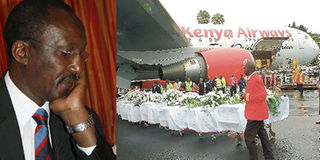Tragedy of KQ 507

Left: Kenya Airways CEO Titus Naikuni (left) during the release of the report in Nairobi. Right: Caskets bearing the remains of the victims of the Cameroon plane crash at the Jomo Kenyatta International Airport, December 2007. Photos/FREDRICK ONYANGO and FILE
Pilot error was the cause of a Kenya Airways plane crash in Cameroon that killed all 114 people on board.
An investigation into the crash says that the pilot and co-pilot made a number of errors and failed to observe standard operating procedures on taking off in bad weather from Douala airport, Cameroon.
Flight KQ 507 crashed on the night of May 4, 2007, shortly after take off.
Using auto-pilot
The plane started its journey in Abidjan, Ivory Coast, and made a stopover at Douala, enroute to Nairobi. The report also partly attributes the crash to bad weather and a manufacturing defect in the Boeing 737-800 that caused the plane to pitch to the right. That could easily have been corrected by a pilot familiar with the problem, but the reports says the aircraft manufacturer omitted the information in the training manual.
Analysis of the Black Boxes, the flight data recorder and the cockpit voice recorder, showed that the captain and his first officer also made wrong decisions when confronted by an emergency, failed to properly communicate and coordinate, and panicked when the situation could still have been salvaged.
“The aeroplane crashed after loss of control by the crew as a result of spatial disorientation ... after a long slow roll during which no instrument scanning was done, and in the absence of external visual references in a dark night,” says the report.
Spatial disorientation is a condition in which an aircraft pilot’s perception of direction does not agree with reality. According to aviation experts, between five and 10 per cent of all general air accidents can be attributed to this condition.
The investigation found that the aircraft started veering to the right soon after take off, but was brought back in line by the captain. The real problem started when the captain signalled that he had switched to auto-pilot, but for unclear reasons the auto-pilot failed to engage.
The result was that for nearly a minute, the pilots were not manually in control of the aircraft and yet it was not on auto-pilot. It then started rolling to the right but with neither manual nor automatic correction.
In pitch darkness, in a rainstorm and with no visual signals such as lights on the ground or a horizon, the pilots did not check instruments and had no other way of telling that the aircraft was veering off course until an alarm sounded.
But then instead of taking proper corrective action, they panicked and plunged the aircraft into a steep dive. Kenya Airways director of flight operations, Mr Paul Mwangi, said that because of the confusion at the airport brought on by a rainstorm, no instrument scanning was done.
“From the time the pilot checks in up to the time he completes the flight, scanning is a requirement whereby whatever change you make, you observe and each of you… because there are two pilots (the co-pilot and the captain) they call out,” said Mr Mwangi.
Odd couple
Although its declared intent is not to apportion blame but to provide recommendations to prevent a recurrence of accidents in future, the report attributed the crash to the pilot, Mr Francis Wamwea Mbatia and co-pilot Andrew Kiuru Wanyoike. Mr Mbatia, 52, was flying with 23-year-old Kiuru and is cited to have “put up a paternalistic attitude towards his First Officer (the co-pilot) during the flight.”
The pair were an odd couple, the pilot with 8,682 flying hours and 16 years’ experience under his belt compared to the co-pilot’s 831 hours and two years of work in a cockpit.
According to the report, the pilot had “ a strong character, heightened ego, was authoritative and domineering on subordinates, which sometimes manifested itself as excessive confidence and a touch of arrogance.”
The co-pilot was, on the other hand, “reserved” and “appeared subdued by the strong personality of his captain. “After take-off, he does not call out the clearly visible and important lapses of piloting, and seems to completely place his confidence in his captain,” reads the report.
Insurance and aviation experts on Wednesday ruled out the possibility of this blame on pilot error opening up a floodgate of new claims against Kenya Airways. A former chairman of Association of Kenya Insurers, Mr Joseph Ngugi, said negligence was among the risks covered by insurance companies.
And a retired aircraft engineer, Mr Joseph Nganga, also ruled out fresh claims against Kenya Airways. The report was published by the Cameroon Civil Aviation Authority on Tuesday.
It says that the very experienced pilot and a fairly inexperienced co-pilot made a series of errors and where they would have corrected the situation with common procedure, worsened the situation.
On Wednesday, while responding to the findings of the investigation, the Kenyan government and Kenya Airways said most of the shortcomings raised in the report had been addressed.
The Boeing 737-800 took off from Douala Airport at 12:06.09 am and crashed 93 seconds later at 12:07.42 am after going into a nose-dive at an altitude of 2,900 feet.




